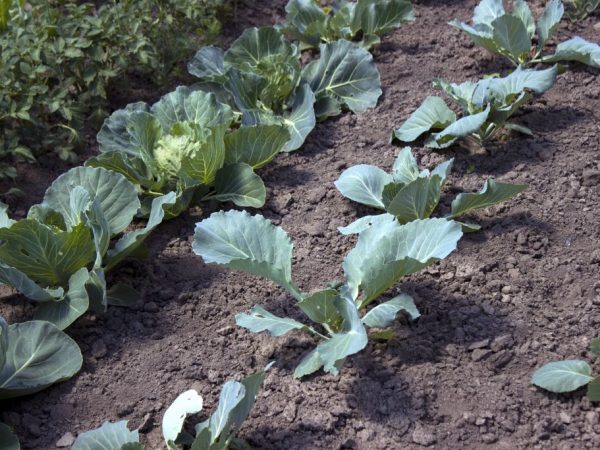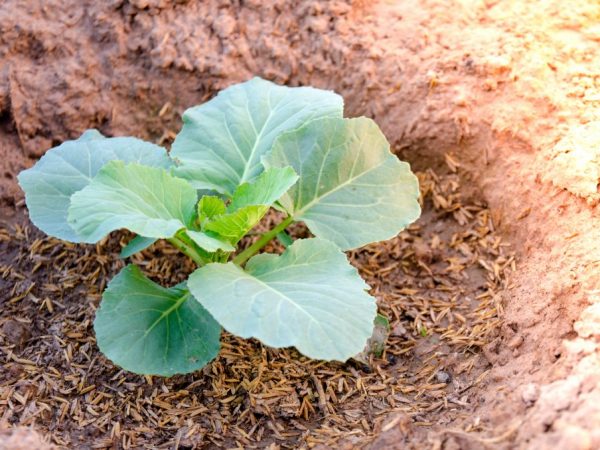Rules for planting late cabbage in open ground
Growing late cabbage is a rather laborious process. This cold-resistant garden crop is very demanding to care for. To obtain a good and high-quality harvest, plantings require a lot of moisture and light. In cultivation, the correct planting of late cabbage is also important.

Rules for planting late cabbage in open ground
Features of culture
Description of late cabbage:
- good yield indicators with competent and timely care;
- long shelf life of heads (up to 9 months);
- harvesting is done not only manually, but also in a mechanized way;
- universal use in cooking - fresh, fermented, stewed;
- newly introduced varieties and hybrids are highly resistant to adverse weather conditions, diseases and pests;
- almost every variety of late cabbage planted in open ground is not afraid of autumn frosts.
The ripening period of heads of cabbage after planting seeds for seedlings is 195 days.
Soil preparation
Planting and growing of late cabbage is carried out in a fertile and structured soil. To get a good harvest, it is necessary to plant this crop on loamy soil with a high humus content. It is in such soil that moisture is retained for the longest, which cabbage loves very much.
For late white cabbage, it is recommended to use soil with a neutral acidity level, as for cauliflower. Any variety of cabbage does not grow well in acidic soil.
The soil on which you plan to plant this garden crop must be dug up in the fall. This will increase its looseness and breathability. During the autumn digging, eggs and larvae of many parasites will be destroyed.
Before planting seedlings on the site, it must be fertilized in early spring. For these purposes, organic matter is used - compost or rotted manure. A bucket of nutrients is added to 1 m2.
To further improve the composition of the soil, mineral components are added to organic matter - phosphorus - 30 g, potassium - 20 g and complex fertilizer - 30 g.
Planting seedlings in open ground
Growing of late cabbage seedlings is carried out at home, on the windowsill, since this culture is afraid of spring frosts. The technology of sowing seeds, caring for them is no different from the technology of growing seedlings of early mid-season varieties. The only difference is the timing. The optimal time for sowing seeds is the last decade of April (25-29 days). This period is suitable for the Urals, the Moscow region and the regions of the middle zone. Early cabbage is planted in late March - early April.
In open ground, tender seedlings of late varieties of cabbage are transplanted after the threat of the last spring frosts has passed.
The planting scheme for late cabbage is as follows:
- distance between plants 55-60 cm;
- row spacing - 60 cm.
The planting scheme for late cabbage can be carried out in a checkerboard pattern.Such a disembarkation significantly saves space on the site.
It is recommended to plant late cabbage in the garden in cloudy weather in the evening. So young and tender seedlings will not burn under the rays of the scorching sun. You need to plant plants to a depth of up to the first leaf. Then compact well around the edges so that the plants take root better and grow upright.
Care features

Surround the cabbage with good grooming
After the planting of late varieties of cabbage on the site has been made, it must be provided with the highest quality and competent care.
Moistening the soil
Regular watering is the most important maintenance condition since cabbage is a moisture-loving crop. Irrigation adjustment is carried out taking into account weather conditions.
Immediately after planting, the plants are watered at the rate of 1 liter. water for one sprout. The next twenty days, the seedlings are watered every 3 days - in the south, in the regions of the middle lane - every 4-5 days. At the same time, 8 liters are consumed per 1 m2 of area. water. After that, watering is carried out once a week with a liquid consumption of up to fifteen liters per 1 m2.
The need for moisture in cabbage increases, especially during the formation of ovaries and heads of cabbage. During this period, the water consumption is about 20 liters. per 1 m2 of land.
After the heads of cabbage are tied up, watering is reduced to 10 liters. to the same area.
If late cabbage is grown for storage, watering is stopped a month before harvest in the middle lane regions, in the south - two weeks before harvesting.
Lighting
This is a light-loving culture, therefore it is recommended to plant it in a place well-lit by the sun. In shading, young seedlings will begin to stretch and will poorly build up green mass, and this will negatively affect the future harvest.
Loosening and weeding
The main care and cultivation of this crop involves regular loosening of the soil. This procedure is carried out every other day after each watering. Loosening increases the moisture and air permeability of the soil.
The planting area should be kept clean and weeded regularly as the weeds grow.
Top dressing
In the process of growing, late cabbage needs additional feeding. For the whole season, late cabbage, like early cabbage, is fertilized four times.
First step
The first top dressing is applied two weeks after planting the seedlings in the ground. In this case, a nitrogen-containing dressing is used, which ensures the growth of leaves during the formation of a rosette. Nitrogen can be contained both in organic matter and in mineral fertilizers.
Possible fertilization options for late cabbage in a ten-liter bucket of water:
- fertilizer with liquid mullein - 0.5 l.;
- ammonium nitrate - 20 gr.;
- top dressing with urea - 20 gr ..
0.5 liters are consumed per plant. nutrient solution.
Second phase

Young cabbage must be fed
Two weeks after the first feed, the second is given. In this case, 1 liter is poured into each hole. liquid top dressing.
At this stage of growth of late white cabbage, complex nutrition is required - organic matter plus mineral supplements:
- Poultry droppings (0.5 kg) are mixed with Azofoska (30 g) and a tablespoon of the drug is added to this mixture - Kristalon, Kemira or Solution. The prepared mixture is diluted in 10 liters. water.
- Chicken manure or compost (0.5 kg), 200 g of wood ash is diluted in 10 liters. water.
Stage Three
This top dressing is applied for later white cabbage. Feeding is carried out ten days after the previous feeding:
- phosphate fertilizers (30 g) are mixed with mullein infusion (1 liter per 10 liters of water);
- phosphate fertilizers (30 g) are mixed with Kristalon, Solution or Kemira (1 tablespoon). The resulting mixture is brought to a volume of ten liters with water.
Consumption - 10 liters per 1 m2 of land.
Such nutrition is required for plants to ripen a juicy and tasty crop.
Fourth stage
The final feeding of the late garden crop is carried out three weeks before harvest.This top dressing will provide the heads of cabbage with a long shelf life.
There are two options for this food:
- 20 gr. potash fertilizers are dissolved in 10 liters. water;
- 0.5 l. the ash infusion is brought to a volume of 10 liters with cold water.
Cutting heads
Heads of cabbage are harvested on the site after the first frosts have passed. It is at this time that you need to remove cabbage from the garden in order to get sweet, juicy and soft heads of cabbage. Late cabbage perfectly tolerates frosts down to -7 °. Therefore, many gardeners specifically wait for the heads of cabbage to freeze slightly, and then harvest the entire crop.
Varieties
The best varieties and hybrids of late cabbage for planting in open ground:
- Moscow;
- Fressor;
- Mara;
- Snow White;
- Amager;
- Wintering;
- Gingerbread man.
These varieties and hybrids are resistant to diseases and pests, take root well in the open field and are intended for long-term storage.
Conclusion
The technology of planting, growing and nursing late cabbage in the open field is quite simple. If you follow it, every gardener, even a beginner, will be able to get a harvest of delicious heads of cabbage.


